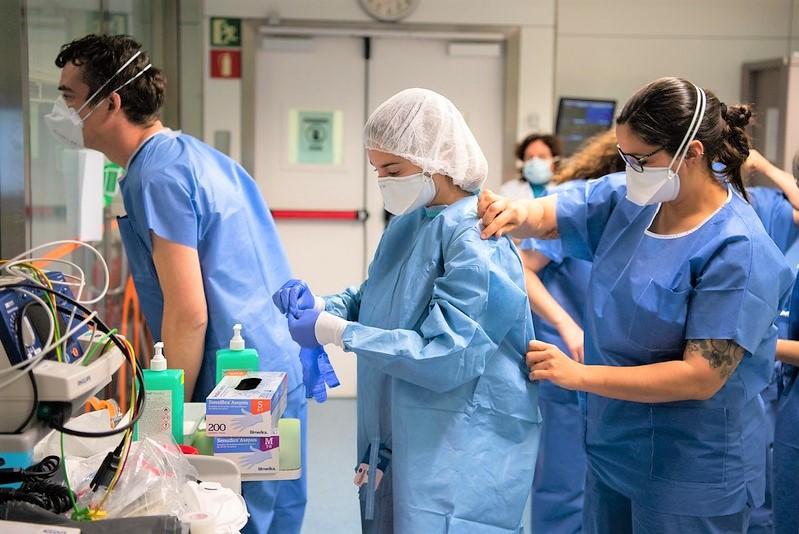Today as confirmed US COVID-19 cases surpass 100,000—continuing a trend of about 20,000 newly reported infections per day—President Donald Trump clashed with governors over ventilator needs despite overwhelmed hospitals in several areas, and he focused again on getting businesses back in operation.
In a letter addressed to the nation's 50 governors, Trump late yesterday said the federal government in the coming weeks intends to classify counties by COVID-19 risk, as part of a plan to reopen businesses in certain parts of the country. According to CNBC, there are 3,141 counties in the United States.
Trump said the plan will be based on surveillance testing, and counties would be designated low-, medium-, and high-risk levels, which would suggest social distancing should be decreased, maintained, or increased.
The letter comes in the wake of several governors petitioning the White House for a more direct federal response to the pandemic, most specifically in obtaining ventilators in the coming weeks. It also comes as the US House passed a major pandemic stimulus bill and new studies point to the ease of disease spread and difficulty in containing it.
Clash over ventilator need
Yesterday the president questioned New York Governor Andrew Cuomo's plea for 30,000 ventilators during a phone call he made during the Sean Hannity show on Fox News. Cuomo has been critical of the president for failing to use the Defense Protection Act to procure ventilators.
"I don't believe you need 40,000 or 30,000 ventilators. You know, you go into major hospitals, sometimes they'll have two ventilators. And now all of a sudden they're saying, 'Can we order 30,000 ventilators?'" Trump said.
Then, today on Twitter, the president seemed to reverse course: "General Motors MUST immediately open their stupidly abandoned Lordstown plant in Ohio, or some other plant, and START MAKING VENTILATORS, NOW!!!!!! FORD, GET GOING ON VENTILATORS, FAST!!!!!!"
In response to Trump, Cuomo told CBS, "I operate on facts, and on data, and on numbers, and on projections. I hope we don't need 30,000 ventilators, I hope some natural weather change happens over night kills the virus globally ... but the numbers say you might need 30,000."
Today the House of Representatives passed a $2 trillion stimulus relief bill, the largest such bill in US history. The passage comes 1 day after the United States surpassed China and Italy as the nation with the most cases of COVID-19 cases in the world.
Today the United States reached 100,717 cases, including 1,554 fatalities, according to the John Hopkins online tracker and New York Times online tracker. Cases have been confirmed in all 50 states.
Surgeon General warns hot spots will worsen
Today Surgeon General Jerome Adams, MD, told CBS This Morning, that next week will be worse for emerging COVID-19 hot spots, including Detroit, Chicago, and New Orleans.
Adams said New York may be reaching a plateau in cases. Today the state tracked 44,635 total cases, including 25,398 in New York City. Since last week, New York has accounted for about half of the US total case count, and with 519 fatalities, about 40% of the nation's deaths.
According to the New York Times case tracker, after New York, New Jersey has the most cases (8,825), followed by California (4,450), Michigan (3,651), Massachusetts (3,240), and Washington state (3,239).
National plasma treatment program launches
A new website for the National COVID-19 Convalescent Plasma Project, spearheaded by Arturo Casadevall, MD, PhD, of Johns Hopkins University, launched today.
The site attempts to coalesce information for providers and researchers on using blood plasma collected from recovered COVID-19 patients—rich in antibodies against COVID-19—to treat those currently ill. It will be tested on patients in New York City's Mt. Sinai hospital, just 3 days after the Food and Drug Administration authorized the compassionate use of convalescent plasma.
According to the New York Times, Mt. Sinai will use the plasma on moderately ill hospitalized patients who are not in advanced stages of COVID-19. About 1 cup of the plasma, which is screened for high levels of antibodies and is free of other diseases, will be given to patients via a drip.
Studies highlight viral shedding, before-symptom spread
A study published yesterday on the preprint server medRxiv studied air and surface samples collected in 11 isolation rooms used to monitor mildly ill or asymptomatic COVID-19 patients at the University of Nebraska Medical Center's Biocontainment Units.
The authors found evidence of viral shedding on several surfaces, as well as evidence of droplet and airborne transmission. Over 80% of participants' personal items, including cell phones, showed evidence of RNA of SARS-COV-2, the technical name for the COVID-19 virus.
"Taken together, these data indicate significant environmental contamination in rooms where patients infected with SARS-CoV-2 are housed and cared for, regardless of the degree of symptoms or acuity of illness. Contamination exists in all types of samples: high and low-volume air samples, as well as surface samples including personal items, room surfaces, and toilets," according to the authors of the study, which has yet to be peer-reviewed.
Finally, a study today in Morbidity and Mortality Weekly Report suggests identifying and isolating symptomatic-only cases in long-term care facilities is not likely to prevent the spread of COVID-19, as half of residents who tested positive for COVID-19 were asymptomatic or pre-symptomatic at the time of testing.
The study is based on tests performed by the Washington State Public Health Laboratory on isolates from the Life Care Center in Kirkland, Washington, which became the first known nursing home outbreak of COVID-19 in the United States.
Upon the identification of an index case on Mar 1, staff at Life Care assessed residents for symptoms, including fever. But 16 days later, widespread testing in the facility showed 30.3% of residents were positive for the virus, half of whom did not have symptoms.
"This analysis suggests that symptom screening could initially fail to identify approximately one half of SNF [skilled nursing facilities] residents with SARS-CoV-2 infection. Unrecognized asymptomatic and presymptomatic infections might contribute to transmission in these settings," the authors concluded.






















